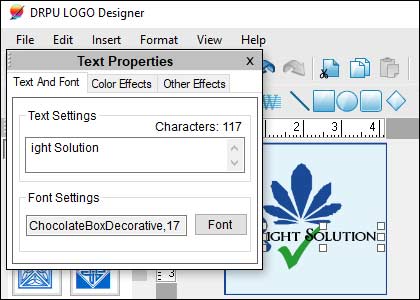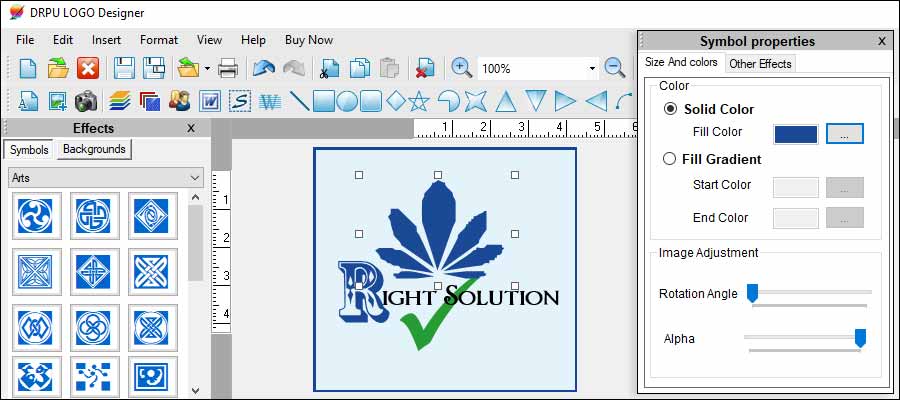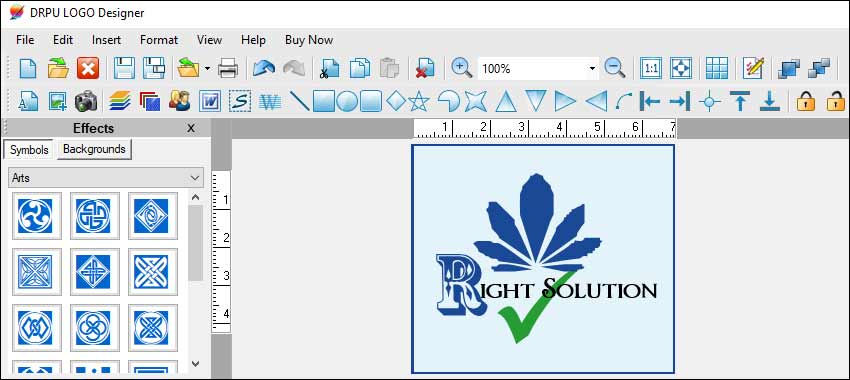Logo Design : Font Selection, Usage, and Suitability in Different Mediums
👤 Digital Deeper
📅
🕔 10 Minutes
Important Font Selection Of Logo Design Maker Software

Font selection is a critical element of logo design. It influences brand identity, readability, recognition, differentiation, consistency, timelessness, cultural considerations, versatility, and emotional impact. By carefully choosing an appropriate font, you can enhance the effectiveness of your logo in communicating your brand's message and resonating with your target audience.
It's important to note that while your logo design is protected by intellectual property rights, it does not prevent others from creating similar or inspired designs. To establish a unique brand identity, it's recommended to conduct a thorough trademark search and create a distinctive logo that sets you apart from competitors.
Font selection plays a crucial role in logo design and can significantly impact the overall look, feel, and effectiveness of the logo. Here's a detailed explanation of the importance of font selection in logo design:
-
01 Brand Personality and Identity:
Fonts contribute to conveying the personality and identity of a brand. Different fonts evoke different emotions and associations. For example, a bold and geometric font might communicate a modern and innovative brand, while a classic serif font may convey tradition and reliability. The font choice should align with the brand's values, target audience, and overall brand identity.
-
02 Versatility and Adaptability:
A logo often needs to be applied across various mediums and sizes, such as print materials, websites, mobile apps, or signage. The chosen font should be versatile enough to adapt to different sizes and formats while maintaining its legibility and impact. Fonts with different weights or variations can provide flexibility in adapting the logo to different contexts.
-
03 Emotional Impact:
Fonts have the power to evoke emotions and create a particular atmosphere. Script fonts may convey elegance and sophistication, while bold and uppercase fonts can communicate strength and authority. Understanding the emotions and associations associated with different fonts can help you select a font that aligns with your brand's desired emotional impact.
-
04 Consistency:
Fonts used in a logo should be consistent with the overall visual identity of the brand. If a brand already has established typography guidelines for marketing materials or website, the logo font should align with those guidelines. Consistency in font usage across brand touchpoints helps in reinforcing brand recognition and creating a cohesive brand experience.
-
05 Timelessness and Longevity:
A well-chosen font can give a logo a timeless quality, allowing it to withstand the test of time and trends. While it's essential to be aware of current design trends, it's generally advisable to opt for fonts that are not overly trendy. Choosing a font that balances contemporary elements with a timeless appeal can ensure the longevity of your logo design.
-
06 Cultural and International Considerations:
Fonts can have cultural and international implications. Different fonts may be associated with specific regions, languages, or design traditions. When designing a logo for a global audience, it's important to research and understand the cultural connotations of fonts to ensure appropriateness and avoid unintended misinterpretations.
-
07 Readability and Recognition:
A logo needs to be easily readable and recognizable, even at small sizes or from a distance. Font selection should ensure legibility and clarity of logo's text. font's readability both in print and digital formats. Fonts with clear, distinct letterforms and appropriate spacing can enhance the logo's recognition.
-
08 Differentiation:
Fonts can help differentiate your logo from competitors and establish a unique brand identity. Choosing a distinctive or custom font can make your logo stand out and create a memorable impression. It's important to avoid using common or overused fonts that may dilute your brand's uniqueness.
Ensure that my logo design is Unique and Memorable

Creating a unique and memorable logo design is essential for establishing a strong brand identity. Here are some detailed steps to ensure your logo stands out:
-
Understand Your Brand:
Start by thoroughly understanding your brand's values, target audience, and overall personality. This understanding will shape the logo design process and help you create a visual representation that aligns with your brand.
-
Research and Inspiration:
Conduct thorough research to identify existing logos in your industry or related fields. This will help you avoid unintentional similarities and gain inspiration for unique design elements. Look for patterns, color schemes, typography choices, and visual styles that resonate with your brand but also differentiate it from competitors.
-
Define a Unique Concept:
A memorable logo often incorporates a unique concept or story. Brainstorm ideas and explore different visual metaphors that relate to your brand's values, products/services, or target audience. Think about what makes your brand special and how that can be visually represented.
-
Sketch and Concept Development:
Start sketching rough ideas on paper to explore various concepts. This stage allows you to quickly iterate and experiment with different shapes, symbols, and compositions. Don't worry about details at this stage; focus on capturing the essence of your ideas.
-
Typography:
Typography plays a crucial role in logo design. Choose a font or create a custom lettering style that complements your brand's personality and message. Ensure the typography is legible, balanced, and harmonious with other design elements.
-
Color Selection:
Colors evoke emotions and can significantly impact the memorability of a logo. Choose a color palette that aligns with your brand identity and consider the psychology behind different colors. Aim for a balanced combination of primary, secondary, and accent colors that enhance the visual appeal and reinforce your brand's message.
-
Simplicity and Scalability:
A memorable logo is often simple and easily recognizable at various sizes and across different mediums. Avoid overcrowding your design with unnecessary elements. Strive for clean lines, minimalistic shapes, and a balanced composition. A simple logo can be more versatile and memorable.
-
Test and Refine:
After creating a few design options, gather feedback from a diverse group of individuals, including your target audience if possible. Consider their opinions, and iterate on the design based on constructive feedback. Refine the concept, typography, color palette, and overall composition until you achieve the desired impact.
-
Intellectual Property Check:
Before finalizing your logo, conduct a thorough search to ensure it doesn't infringe on existing trademarks or copyrighted materials. This step is crucial to avoid legal issues and protect your brand's integrity.
-
Consistency:
Once you have a finalized logo, ensure its consistent usage across all your brand touchpoints, such as your website, social media profiles, packaging, and marketing materials. Consistency in application reinforces the memorability of your logo and builds brand recognition over time.
Remember, creating a unique and memorable logo takes time, effort, and creativity. By following these steps and collaborating with professional designers if needed, you can develop a logo that captures the essence of your brand and leaves a lasting impression on your audience.
Can I use my Logo Design for Commercial Purposes
Yes, you can use your logo design for commercial purposes. However, it's important to understand the legal aspects and considerations related to logo usage. Here are some details to keep in mind:
-
Intellectual Property Rights:
When you create a logo design, it automatically becomes your intellectual property. Intellectual property refers to the legal rights associated with creations of the mind, such as inventions, artistic works, and designs. As the creator of the logo, you hold the copyright to it, unless you transfer the rights to someone else through a contract or agreement.
-
Trademark Protection:
To further protect your logo design and prevent others from using a similar logo in your industry, you may consider applying for trademark registration. Trademarks provide exclusive rights to use a particular logo, name, or slogan in connection with specific goods or services. Registering your logo as a trademark offers legal protection and allows you to take legal action against infringement.
-
Logo Usage Policy:
While you have the right to use your logo design for commercial purposes, it's essential to establish a clear logo usage policy. This policy outlines guidelines for how the logo should be used, ensuring consistency and protecting the integrity of your brand. It may include specifications on size, placement, colors, background usage, and any other relevant considerations.
-
Licensing and Permissions:
If you want to grant others the right to use your logo design, you can do so through licensing agreements. Licensing allows you to give others permission to use your logo in exchange for certain conditions, such as royalties or specific usage limitations. Licensing agreements ensure that you retain control over your logo and how it is represented.
-
Copyright Infringement:
As the owner of the logo design, you have the right to enforce your copyright and take legal action against individuals or entities that infringe upon it. If you discover unauthorized use of your logo, you can send cease and desist letters or pursue legal action to protect your rights.
-
Hiring a Professional:
If you're uncertain about the legal aspects or want to ensure your logo design is fully protected, it's advisable to consult with an intellectual property attorney. They can provide guidance on copyright laws, trademark registration, and help you draft licensing agreements or usage policies.

In summary, you have the right to use your logo design for commercial purposes as the creator and copyright holder. Consider trademark registration, establish a logo usage policy, and explore licensing options if needed. It's always wise to seek legal advice to ensure full protection of your logo and brand assets.
Ensure that my logo design is Scalable and Suitable for Different Mediums
Ensuring that your logo design is scalable and suitable for different mediums is crucial for maintaining its visual integrity and legibility across various applications. Here's a detailed explanation of how to achieve scalability and versatility:
-
Simplify the Design:
Start with a clean and simple logo design. Complex and intricate details may not translate well when the logo is scaled down or reproduced in smaller sizes. Aim for a design that can be easily recognizable even when reduced to a small scale. It will allow your logo to maintain its impact and recognition regardless of the size.
-
Use Vector Graphics:
Create your logo design using vector graphics software, such as Adobe Illustrator or CorelDRAW. Vector graphics are resolution-independent and based on mathematical equations, allowing them to be scaled up or down without any loss of quality. This ensures that your logo remains clear across different sizes.
-
Test at Different Sizes:
During the design process, test your logo at various sizes to ensure its legibility and visual impact. Evaluate how it looks when scaled down to a small favicon or when enlarged for a billboard. This way, you can identify any elements that become too small or lose their clarity, and make necessary adjustments.
-
Consider Proportions:
Pay attention to the proportions of your logo design. Ensure that the relative sizes of different elements within the logo maintain a harmonious balance when scaled up or down. Proportional consistency allows the logo to be easily adapted to different sizes without losing its overall aesthetic appeal.
-
Typography Legibility:
If your logo includes text, select a font that remains legible at different sizes. Avoid overly complex or decorative fonts that may become difficult to read when scaled down. Test the legibility of the typography by viewing it at small sizes and ensuring that all characters are clear and distinguishable.
-
Responsive Design:
Creating responsive variations of your logo to adapt to different mediums or orientations. This could include simplified versions for small applications for vertical spaces. By optimizing your logo for specific contexts, you can ensure it looks visually appealing and maintains its impact across a range of mediums.
-
Color Considerations:
Choose a color palette that works well in both digital and print formats. Ensure that the colors remain vibrant and consistent when reproduced across various mediums, such as screens, printed materials, or promotional items. Test the logo in different color spaces (RGB, CMYK, Pantone) to maintain color accuracy.
-
Test on Different Backgrounds:
Ensure your logo design works effectively on different backgrounds, such as light, dark, or colored surfaces. Test the logo on various background colors to ensure sufficient contrast and readability. Consider providing versions of the logo with different color variations or background treatments if needed.
-
Style Guide:
Create a comprehensive style guide that outlines guidelines for logo usage, including minimum size requirements, clear space around the logo, and placement rules. This guide will help maintain consistency and ensure that your logo is applied correctly across different mediums by you and others who use that logo.
By following these steps, you can design a logo that is scalable, adaptable, and suitable for a variety of mediums.